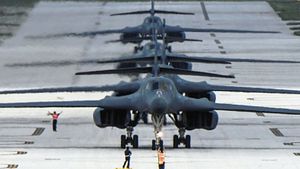The U.S. Air Force (USAF) and Japan Air Self-Defense Force (JASDF) held a joint air drill near the disputed Senkaku islands in the East China Sea on August 15, the U.S. Pacific Air Forces announced in a statement today.
Two USAF B-1B Lancer heavy strategic bombers of the 37th Expeditionary Bomb Squadron, temporarily stationed at Andersen Air Force Base on Guam in the Western Pacific, joint two JASDF F-15J fighter jets in the vicinity of the Senkaku islands in the East China Sea in a joint training mission.
“These training flights with Japan demonstrate the solidarity and resolve we share with our allies to preserve peace and security in the Indo-Asia-Pacific,” the August 16 statement reads. Beijing and Tokyo both claim sovereignty over this group of uninhabited islands, known in China as the Diaoyus and the Senkakus in Japan.
Pacific Air Forces did not provide additional details of the air drill.
The Mitsubishi F-15J all-weather air superiority fighter, a Japanese variant of the McDonnell Douglas F-15 Eagle, is the workhorse of the JASDF. Japan currently operates around 215 F-15J (including the upgraded F-15DJ/F-15J Kai versions) of the fighter jet which were built under license by Japanese defense contractor Mitsubishi Heavy Industries. The first license-built aircraft entered service with the JASDF in 1981.
USAF B-1B patrols and air drills have become a regular occurrence in East Asia. Two B-1B Lancer heavy strategic bombers from Andersen Air Force Base last conducted sequenced bilateral training missions with JASDF and Republic of Korea Air Force (ROKAF) in late July in response to North Korea’s purported second-ever flight-test of the Hwasong-14/KN20 intercontinental ballistic missile (ICBM) on July 28.
“The USAF’s 62 B-1B Lancers are capable of carrying up to 75,000 pounds (34,000 kilograms) of weapons — the largest payload of both guided and unguided weapons in the USAF’s inventory. Though heavily armed, the bomber can reach a top speed of Mach 1.2 and can operate at altitudes above 30,000 feet (9,100 meters),” I explained elsewhere. However, despite various media reports, the USAF’s B-1B fleet is no longer nuclear-capable following conversion to a conventional-only delivery platform beginning in 2007.
B-1Bs also took part in two separate air drills with the JASDF and ROKAF following the the death of Otto F. Warmbier, a U.S. citizen who was evacuated from North Korea in June. Additionally earlier that month, two B-1B bombers from Andersen Air Force Base conducted a training exercise in the South China Sea in conjunction with the U.S. Navy’s Arleigh Burke-class guided missile destroyer USS Sterett.

































